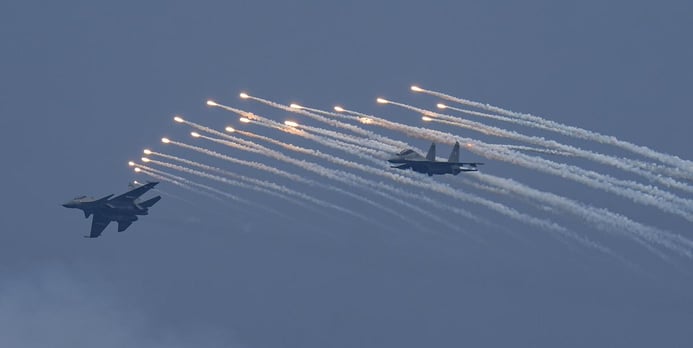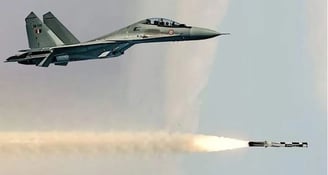Su-30 MKI: The Crown Jewel of Indian Air Power
In the complex and rapidly evolving domain of modern aerial warfare, where multirole capabilities, situational awareness, and sustained long-range engagement define a nation’s air dominance, the Sukhoi Su-30MKI has carved an indelible niche for itself. As the most potent air superiority fighter in the Indian Air Force (IAF) inventory, the Su-30MKI serves as the backbone of India's aerial might. With its twin engines, thrust-vectoring capabilities, and deep strike endurance, it has consistently demonstrated dominance in both peacetime patrols and high-tempo war exercises.
Jointly developed by Russia’s Sukhoi Design Bureau and India’s Hindustan Aeronautics Limited (HAL), the Su-30MKI is a customized variant designed to suit India’s unique geopolitical challenges, operational philosophies, and indigenous capabilities. With over 270 aircraft in service, and more being upgraded under the “Super Sukhoi” programme, this platform is central to India’s air doctrine and strategic deterrence in the Indo-Pacific region.
1. Engineering Marvel: Design and Technical Superiority
At first glance, the Su-30MKI is a study in aerodynamic grace and raw power. It is a twin-seat, twin-engine, long-range air dominance fighter with deep strike capability, aerial refueling, and full multirole flexibility. The aircraft is 21.9 meters in length, 6.4 meters tall, and has a wingspan of 14.7 meters. Its size and design lend themselves to significant internal fuel capacity and multiple hardpoints for varied mission payloads.
A hallmark of the Su-30MKI is its thrust vectoring control (TVC) and canard foreplanes, which provide it with superior agility. This 4++ generation aircraft is capable of supermaneuverability—executing high-angle-of-attack maneuvers and tight turns not possible with traditional aerodynamic control surfaces alone. In combat, this provides an edge in dogfights and close-quarters aerial engagements.
Key Performance Parameters:
Maximum speed: Mach 2 (2,120 km/h)
Range: 3,000 km unrefueled (extendable via aerial refueling)
Service ceiling: 17,300 meters
Rate of climb: 230 m/s
Combat radius: ~1,500 km with full weapon load
This range and versatility allow the Su-30MKI to conduct long-endurance patrols in the Bay of Bengal, perform deep strikes in hostile airspace, or conduct escort and suppression missions, all from the same platform.




4. Operational Achievements and Combat Exercises
Though India has not engaged in full-scale aerial combat since the Kargil conflict (prior to Su-30MKI's full induction), the aircraft has proven its mettle in various high-intensity scenarios and joint exercises.
Key Operational Highlights:
Balakot Air Strike (2019): Su-30MKIs provided aerial escort and air dominance cover to Mirage-2000s executing deep strikes across the LoC.
Doklam Crisis (2017): Su-30MKIs were deployed to forward bases in Assam, conducting round-the-clock patrols and deterring PLA Air Force presence.
Eastern Ladakh Standoff (2020-2021): Regular Combat Air Patrols (CAPs) and live-fire drills with BrahMos and indigenous weapons reinforced deterrence against Chinese PLAAF.
International Exercises:
Red Flag (USA), Indra (Russia), Garuda (France), Cope India (USA), Pitch Black (Australia): Su-30MKIs consistently outperformed Western platforms in simulated combat, especially in within-visual-range (WVR) engagements. Western air forces have repeatedly acknowledged the aircraft's agility and pilot skill.
5. Towards Super Sukhoi: Modernisation and Indigenisation
India’s long-term vision is to modernize the Su-30MKI fleet into a 5th-generation capable 4++ platform, known as the Super Sukhoi standard. The program, led by HAL and DRDO, includes:
Upgraded Radar: AESA radar derived from DRDO’s Uttam AESA or Russian Zhuk-AM.
New Weapons: Integration of newer Astra variants, anti-ship missiles, and long-range glide bombs.
Stealth Features: Reduction in radar cross-section and engine nozzle signature.
EW and Avionics: New-generation Israeli EW suites, Indian software-defined radios (SDR), and AI-assisted mission computers.
Engine Overhaul: Prospective upgrade of AL-31FP engines with enhanced thrust, service life, and reliability.
This upgrade would make the Su-30MKI fleet relevant till the 2040s and form a potent mix alongside the Rafale, Tejas Mk-2, and AMCA (Advanced Medium Combat Aircraft).
6. Strategic Significance in the Indo-Pacific Equation
In a geopolitical environment marked by an assertive China and unstable Pakistan, the Sukhoi Su-30MKI plays a pivotal deterrent role. With its ability to be deployed rapidly from bases in the North-East, Rajasthan, Andaman & Nicobar Islands, and Tamil Nadu, the aircraft bridges strategic gaps.
Geopolitical Edge:
Against China: Can be deployed in Arunachal Pradesh and Ladakh. Equipped with BrahMos, it can threaten Chinese naval and military installations in the South China Sea.
Against Pakistan: Flies regular CAPs near the International Border (IB) and Line-of-Control (LoC); can strike terror camps, supply depots, and nuclear facilities, if required.
Maritime Role: Paired with P-8I maritime surveillance and naval assets, Su-30MKI extends India’s sea-denial capability.
The IAF is also exploring MALD (Miniature Air-Launched Decoy) and SWiFT wingman drones to operate alongside Su-30MKIs, expanding its battlefield impact and survivability in high-threat airspace.
7. Limitations and Areas for Improvement
Despite its many advantages, the Su-30MKI is not without its challenges:
Maintenance and Availability: Initially plagued by low availability rates (50-60%), although now improved to ~75%.
Logistical Dependence on Russia: The Ukraine conflict has exposed vulnerabilities in the Russian supply chain, prompting a greater push for indigenisation.
Weight and Radar Signature: Its large size increases its radar cross-section, making it less stealthy than modern fifth-gen fighters.
India is mitigating these challenges through increased HAL assembly line efficiencies, spare part localisation, and planned integration of Indian-made radars and engines.
Conclusion: The Sky is Not the Limit
The Sukhoi Su-30MKI is not just an aircraft—it is a symbol of India’s military diplomacy, technological integration, and strategic autonomy. With its unmatched versatility, extended reach, and relentless upgrade potential, it will remain the workhorse and vanguard of Indian airpower for decades to come.
As India steers into an era of greater defence self-reliance through Make in India, projects like the Super Sukhoi, Astra missiles, and indigenous avionics will transform this Russian-origin platform into a truly Indian force multiplier.
In the unforgiving skies where only the best survive, the Su-30MKI has proven again and again—it’s not just a fighter; it’s the Twin-Spined Titan of Indian Skies.
